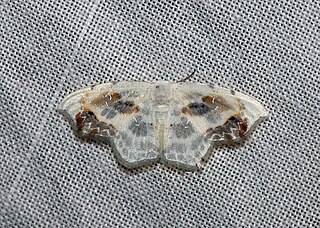| Nothoploca nigripunctata | |
|---|---|
| Scientific classification | |
| Kingdom: | Animalia |
| Phylum: | Arthropoda |
| Class: | Insecta |
| Order: | Lepidoptera |
| Family: | Drepanidae |
| Genus: | Nothoploca |
| Species: | N. nigripunctata |
| Binomial name | |
| Nothoploca nigripunctata (Warren, 1915) | |
| Synonyms | |
| |
Nothoploca nigripunctata is a moth in the Drepanidae family. [1] It is found in India, Vietnam, Korea, China and the Russian Far East. [2]

Moths comprise a group of insects related to butterflies, belonging to the order Lepidoptera. Most lepidopterans are moths, and there are thought to be approximately 160,000 species of moth, many of which have yet to be described. Most species of moth are nocturnal, but there are also crepuscular and diurnal species.

The Drepanidae is a family of moths with about 660 species described worldwide. They are generally divided in three subfamilies which share the same type of hearing organ. Thyatirinae, previously often placed in their own family, bear a superficial resemblance to Noctuidae. Many species in the Drepanid family have a distinctively hook-shaped apex to the forewing, leading to their common name of hook-tips.

India, also known as the Republic of India, is a country in South Asia. It is the seventh largest country by area and with more than 1.3 billion people, it is the second most populous country as well as the most populous democracy in the world. Bounded by the Indian Ocean on the south, the Arabian Sea on the southwest, and the Bay of Bengal on the southeast, it shares land borders with Pakistan to the west; China, Nepal, and Bhutan to the northeast; and Bangladesh and Myanmar to the east. In the Indian Ocean, India is in the vicinity of Sri Lanka and the Maldives, while its Andaman and Nicobar Islands share a maritime border with Thailand and Indonesia.
The wingspan is about 32 mm. The forewings are bluish white speckled with pale grey, the inner and outer bands and the terminal area tinged with brownish. The inner line is black, waved and runs from two-fifths of the costa to near the middle of the inner margin. It is preceded by three thick waved dark lines filled in with brown and there is a dark spot near the base of the submedian fold, followed by a black pointed dash. The basal area is limited by a curved dark line and the outer line is black, double, vertical at the costa, then excurved to vein 2 and again to vein 1, approaching the inner line on the inner margin. There is a pale and dark grey dentate line beyond and the subterminal line is white, defined by the dark terminal area beyond, and an oblique black streak from the apex. There is also a black terminal festoon. The hindwings are dull fuscous. [3]

The wingspan of a bird or an airplane is the distance from one wingtip to the other wingtip. For example, the Boeing 777-200 has a wingspan of 60.93 metres, and a wandering albatross caught in 1965 had a wingspan of 3.63 metres, the official record for a living bird. The term wingspan, more technically extent, is also used for other winged animals such as pterosaurs, bats, insects, etc., and other fixed-wing aircraft such as ornithopters. In humans, the term wingspan also refers to the arm span, which is distance between the length from one end of an individual's arms to the other when raised parallel to the ground at shoulder height at a 90º angle. Former professional basketball player Manute Bol stands at 7 ft 7 in (2.31 m) and owns one of the largest wingspans at 8 ft 6 in (2.59 m).


